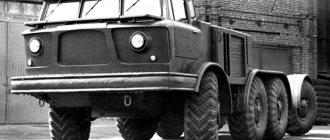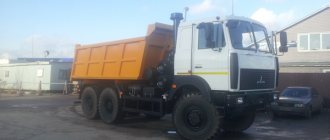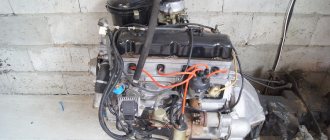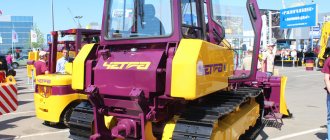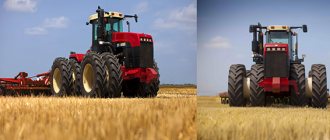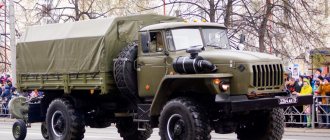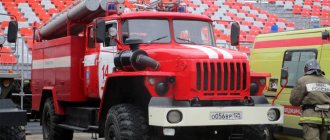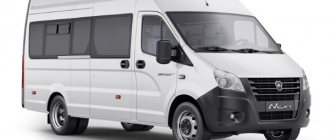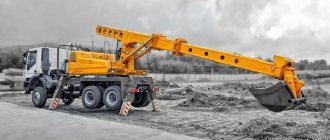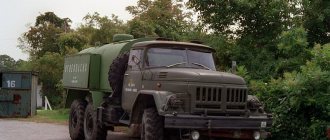Specifications
The basis of the vehicle is an all-welded iron frame, which is highly durable. Single wide wheels with all-wheel drive provide stability on the highway and good cross-country ability off-road. TTX Ural-4320:
- length - 740 cm;
- width - 250 cm;
- height - 290 cm;
- wheelbase - 360 cm;
- rear and front track - 200 cm;
- ground clearance - 40 cm;
- minimum turning radius - 1150 cm;
- weight of a military vehicle with refueling - 8000 kg;
- load capacity - 6850 kg,
- towed trailer weight - 11500 kg;
- seats for transporting passengers - 27-36.
During the production period the following modifications of military vehicles were produced:
- with an extended body;
- with reinforced front suspension;
- with increased load capacity;
- tractor unit;
- lightweight with a 4x4 wheel arrangement.
The base model remains a body version with an awning, intended for transporting cargo and personnel.
Transmission
The Ural truck has a 6x6 wheel arrangement. Each wheel is equipped with an automatic inflation and maintenance system for air pressure. The dependent front suspension is mounted on semi-elliptical springs with shock absorbers. The rear wheels are mounted on springs with reaction bars. The disc clutch is equipped with a friction drive and a pneumatic booster. The gearbox is mechanical. There are 10 forward and 2 reverse speeds. The transfer mechanism is synchronized and has 2 gears. It contains a center differential lock that evenly distributes torque between the front axle and the rear bogie. The transmission of draft force is carried out through 4 cardan shafts.
Brake system
The main dual-circuit hydraulic system with all-wheel drive. Slowing down the speed and stopping the machine is carried out by single or multiple pressing of the foot on the pedal located in the floor of the cabin. Drum brakes, 2 pads on each wheel. The auxiliary unit is pneumatic and operates from the exhaust system. The drum-type parking brake is installed on the transfer case shaft. Ensures that the machine is held on a slope or stopped at low speed in the event of a breakdown of the main and backup systems.
Engine
The first models of the army all-terrain vehicle were equipped with KamAZ-740.10 engines from the Kama Automobile Plant. The engine had 8 cylinders with a total volume of 10.9 liters and a power of 230 hp. Subsequently, designers began to equip the Urals with a YaMZ power unit from the Yaroslavl Motor Plant. The latest models are equipped with 238 series motors. The technical characteristics of this engine are as follows:
- type - V-shaped diesel;
- number of cylinders - 8;
- rated power - 240 hp;
- working volume - 14.86 l;
- number of revolutions per minute - 2600;
- maximum torque - 882 Nm;
- cooling - liquid forced;
- power supply system - mechanical in-line injection pump;
- maximum speed - 85 km/h;
- fuel consumption per 100 km - 32-40 l;
- fuel tanks - main 300 l and additional 60 l;
- climbability - 58%;
- Power reserve - 1000 km.
The power unit is equipped with a heating device for starting in the cold season. The engine is installed under the hood, located in front of the cab. Modern models are equipped with an aerodynamic bumper with an optical system. The cabin is finished with plastic fairings that reduce drag and give the car an attractive appearance.
Transportation options
The floor of the base model is made of sheet metal 3-4 mm thick. The side opens backwards, there are folding chairs in the body, and provision for fastening benches. The side boards are solid or lattice panels. The vehicle is capable of transporting up to 36 lightly equipped or 24 fully equipped military personnel. The durable frame and suspension can withstand heavy piece or bulk cargo. On the platform of the car you can attach a change house, a passenger compartment with chairs, a repair shop or a hospital ward. If there are guy ropes, it is possible to transport machines and industrial equipment. A truck is used to transport food, consumer goods and other materials.
Catalog of spare parts for URAL-43206-(43206-41):
Our catalog contains all spare parts used in URAL-43206-41. Select the node you need. To make it easier to find spare parts for URAL-43206-41, you can use the quick filter.
Quick Filter by nodes:
- Body Body
Cabin assembly
- Body floor Arm seals and cab floor mats
- Windshield wiper and its drive
- Cabin doors
- Driver and passenger seats
- Cabin ventilation and heating
- Radiator trim
- Platform
- Engine
EngineEngine mount
- Crankcase ventilation
- Installation of preheating system units
- Pipes and hoses of the preheating system
- Pre-heater boiler
- Pump unit supercharger
- Fuel pump pump unit
- Main fuel tank
- Exhaust system
- Cooling system radiator
- Clutch
Drive of clutch and brake pedals with pneumohydraulic control
- Installing the gear shift lever
- Transfer case housing and suspension
- Cardan transmission
- Front axle housing
- Rear axle housing
- Frame, bumpers and engine mudguards
Frame
- Front suspension
- Wheel and tire
- Steering control
Steering control
- Service brake
- Electrical equipment
Headlight
- Dashboard
- Fifth wheel device
Towing
- Additional power take-off
- Winch with cable laying assembly
- Unit sealing system
Cabin of the Ural Next car
The doorway is quite high (the door handle is taller than the average person). However, getting into the cabin is comfortable, thanks to well-placed steps. The lower one, by the way, hangs on a flexible metal cable. This solution is more beneficial from the point of view of simple practicality. Foreign manufacturers in such cases use either rigid folding metal structures or a step on a rubber loop. Both are dubious solutions: folding steps are easy to break on difficult terrain, and rubber hinges simply cannot withstand Siberian and northern frosts. Having climbed into the cabin, the driver finds himself in the interior of a GAZelle or GAZon with the Next prefix - the cabin is the same for all three families of the GAZ Group. The only difference is the key block on the front panel, which is responsible for controlling the transmission. Now on the Ural the front axle and downshift can be engaged by pressing a button rather than using a lever. Without exaggeration, the small GAZelle steering wheel makes a stunning impression on drivers - in size it seems just like a toy and is located almost vertically. Everyone is accustomed to the fact that heavy trucks have huge “steering wheels” of impressive diameter, located more horizontally. Driver comfort has been raised to an unheard of level, compared to the classic Ural. His seat in the Ural Next is equipped with air suspension (these are made in Yelabuga, at the TIS LLC enterprise); the steering column can be adjusted in angle; The cabin is equipped with an on-board computer with a display; On the steering wheel there are radio control keys (this is in the Urals!). The sound insulation and tightness of the new cabin also cannot be compared with the old one. In the basic configuration, the Ural Next has electric windows and electric mirrors, central locking, fuel filters and heated fuel intakes. It’s strange to see on the dashboard a tachometer marked up to 4000 rpm and a speedometer with a maximum speed of 160 km/h. In fact, the YaMZ-536 spins up to 2300 rpm, and the maximum speed of the all-wheel drive Ural Next is limited to 85 kilometers per hour. For a better guide to operating the car, a special sign has been made for drivers, from which you can determine what the tire pressure should be when driving on different types of soil. The sofa for two passengers does not have air suspension, but is spacious enough for two to sit even in winter work clothes.
The lineup
An early model of a fire tank is the Ural AC-40 or PM-102, built on a Model 375E chassis. The fire pump is located in the driver's cabin; the suction pipes are located under the running boards on both sides of the vehicle. Above there are outlets of the pressure lines to which the hoses are connected. The crew of the fire truck is located in a twin cabin. A barrel is installed on the roof to supply extinguishing agent to the fire site. The AC 3.0 40 vehicle on the Ural-43206 has a combat crew consisting of 6 people. The capacity of the steel tank is 3000 liters; an additional tank for a foaming agent is installed, designed for 180 liters of liquid. A centrifugal pump and distribution unit are installed in the aft part of the superstructure. On the basis of the Ural-4320, the AC 8.0 40 tank was produced, designed for 8000 liters of water and 500 liters of foam concentrate. The pumping station is located in the cabin for the combat crew, consisting of 6 people. There is a modification AC 10.0 70, which has a water supply of 10,000 liters on board. Due to the installation of increased containers and additional equipment, the crew was reduced to 3 people. The fire tanker model AC 5.5-40 is equipped with an all-metal twin cabin with 4 doors. The rear section of the cabin is widened, allowing for increased capacity. The front row is equipped with a driver's seat and a separate sofa for 2 people. The rear deck is designed for 4 crew members. The backs of special seats have niches for storing breathing apparatus. Behind the cabin there is a storage compartment for 360 liters of foaming composition and a tank designed for 5500 liters of water. The upper part of the superstructure is treated with a special rubber coating. The design uses an electronic module that allows you to evaluate the supply of liquid and composition on board. A pumping unit is installed at the rear of the machine, driven by the gearbox of the base chassis. The pump supplies up to 40 liters of extinguishing agent per second under excess pressure. On the basis of Ural trucks, it is possible to install sliding stairs. An example of such an installation is the ACL 6.0 50/4 18 machine. There is a supply of water (6000 l) and foam concentrate (400 l) on board. The mixture is supplied by an imported pump supplied by the German company Jonstadt. On the roof of the superstructure there is a staircase consisting of several sections. The maximum height reach is 18 m.
Modifications
The basic all-wheel drive model became the basis for the creation of various modifications. They adopted its main advantages: excellent cross-country ability, the ability to move on any roads.
Let's talk about other versions:
- Option with tank 43206 AC-3.0-40. A tank with a capacity of 4 m3 is installed on the car. This modification is used as a fire truck. It is possible to additionally place a foam formation tank with a volume of three hundred liters. The presence of two rows of seats allows a fire crew of six people to sit in the car.
- Modification 43206 (4121-79M) compares favorably with its peers in the model range in terms of equipment. It contains a DOM pneumatic control unit, a spare valve control device, a power take-off with a pump, and a sleeping place.
- Many military modifications with installation of various combat and additional equipment on the chassis (Grad installation, etc.).
The version with a chassis is popular not only in the army, but also in the national economy. This model is used for transporting equipment, special equipment, etc.
This is interesting: Tactical and technical characteristics of AC-3.0-40-43206-001MI
First firefighter Ural next
Miass LLC "Prioritet" is conducting design documentation for the preparation of production of an expanded family of fire fighting vehicles on the Ural NEXT chassis. The work here is very responsible and involves conducting a whole R&D with the determination of technical data and parameters for fire trucks with cabins of the new “Next” standard size. First of all, it is necessary to put into production firefighting, pumping and hose vehicles, as well as tank trucks AC-4.0 and AC-6.0 on the chassis of the updated Ural-4320 and Ural-5557 with a new tail and cabin. The design feature of the new Ural NEXT cabin forced us to work out several layout options for the location of the combat crew: a basic double cabin, a double cabin (the so-called “doublet”) and an integrated cabin (when the cabin and body form a single whole). Initially, it was assumed that car designers would adjust the new cabin to the existing chassis, so as not to change the mounting base. This would ensure the use of old bodies on old chassis. It is necessary to take into account the features of off-road operation. The SUV frame experiences alternating off-road loads. Therefore, the integrated cabin had to be abandoned immediately. “Doublet cabins” also cannot be a panacea, since they are expensive to manufacture. Therefore, for the first samples, standard cabs from the new generation of GAZon Next medium-duty trucks were taken, closely unified with the GAZelle Next reference cabs. But then a problem arose due to cramped space. The fire crew leaves the cabin in full gear with backpacks and equipment. The priority choice of the GAZelle Next base cabin as the initial one with a two-row seat arrangement for combat crews promises benefits only in production. But not in operation! In fact, automakers from Miass are offered to receive a ready-made “greenhouse” from Nizhny Novgorod - a cabin unit. But it is not convenient for the needs of firefighters and the Ministry of Emergency Situations. During the timing, it turned out that in the standard double cockpit the combat crew did not have time to turn around with full combat gear and was delayed due to cramped conditions. Testing was carried out in full combat gear with equipped backpacks. In addition, in the GAZelle Next cabin it is necessary to place additional cabinet boxes and cases for equipment and gas masks. And all this should either be rearranged, or the standard NEXT crew cab should be abandoned.
Ural Next Priority AC-4 Ural-4320 FIRE GROUP
The floating fire tanker ATs-4.0 on the Ural-4320 chassis has been tested /+video/
from Miass (Chelyabinsk region) in 2015 produced the first domestic fire-fighting floating tanker ATs-4.0. The first photographs were presented at the Interpolitex-2015 exhibition, held in Moscow at VDNKh last fall. At the exhibition itself, the concept of the machine aroused unprecedented interest from not only Russian law enforcement agencies, but also representatives of foreign countries.
By that time, the editors had several photographs of the new product: a general view photo and a photograph submerged on a pond from testing. It followed from this that the machine still exists in metal, which we wrote about in November.
Representatives of the company asked the editors of Truck Press to just be patient until the spring, when they were supposed to publish a promotional video of the video after the water test cycle. The company kept its word and posted a video from tests conducted jointly with representatives of the Ministry of Emergency Situations.
In the video you can see some of the stages of preparing the car for launching. To do this, a special shield is installed on the bumper in front of the radiator - a wave barrier. As you can see, the radiator trim is raised higher than the car frame. In addition, mud flaps are secured under the body. Propulsion on the water is provided by propellers.
The vehicle with a KAMAZ cab on the Ural-4320 chassis is capable of overcoming deep water obstacles and participating in emergency response efforts in hard-to-reach areas. The area of application covers all geographical and geological areas, perhaps only with the exception of the volcano crater.
The KAMAZ cabin was not chosen by chance; it has good tightness and is technologically proven. However, when moving on the water surface, it is not necessary to seal the cabin to improve buoyancy or stability, as some readers may assume. To pump water out of the cabin, a drainage unit is provided, which discharges water overboard through two holes mounted on the rear pillar of the cabin on the right.
In the video you can see that the windows in the doors are open and even the roof hatches are open! The floating fire tanker ATs-4.0 is equipped with a sealing system for all components and assemblies, the engine and compartments, which makes it a unique offer on the special fire equipment market. From the video it is noticeable that the car develops 3-4 knots on the water. Translated into land kilometers, this will be within the range of 5.5 – 7.4 km/h.
The hermetically sealed cargo compartment houses firefighting equipment and equipment from the Moscow Fire Group LLC, which is known as FIRE GROUP, and a 4000 liter water tank. Arches are provided for attaching the awning. Our own pumping installation allows you to pump water into the tank using direct intake from a reservoir, river or lake.
High ground clearance, 6x6 wheel arrangement and adjustable tire pressure allow you to operate the machine not only in wetlands, but also confidently go into the water and go ashore. The amphibious ability to overcome water obstacles will allow the fire crew not to look for a ford with the risk of drowning the car, but to force the water obstacle. The all-wheel drive vehicle can be used not only for fire protection, but also for water rescue operations.
Will the new cabin from Ural Next be used? As we have already written, Priority LLC is already producing fire trucks with Next generation cabins. But this is unlikely to happen in the near future. The KAMAZ cab has been used in service and spare parts for it can be found everywhere. But the Nexta cabin is still a curiosity.
The specifications of the machine are currently being finalized. That is why the company’s engineers are very reluctant to share technical characteristics. This makes sense, since even during trial operation the equipment changes.
www.gruzovikpress.ru
Advantages of fire fighting equipment on the Ural chassis
The fire truck chassis cannot be chosen at random. "Ural" is suitable for the stated purposes due to a number of advantages:
- Prepare for harsh conditions
. "Ural" is produced in a region with a harsh continental climate, this car is not afraid of either heat or bitter frosts, and the lack of an adequate road will not be a big problem either. - Reliability
. The constant presence of the chassis on the market for over forty years indicates the complete indestructibility of the base and its readiness to serve forever. - Low cost
. “Ural” is produced within the country, production is located relatively close, so delivery of the chassis to equipment is cheap, and there are no inflated customs duties either.
Miass fire trucks are heavy tank trucks with a mandatory telescopic ladder. The models differ from each other mainly in the tank capacity and partly in the set of fire-fighting equipment.
Request a quote
Dealer map
Our company has a wide dealer network. You can find a dealer of our products in any region of Russia.
More details
Financial services
Our company cooperates with leading leasing companies for the purchase of specialized equipment.
More details
Service and guarantees
The company guarantees service (service) for UMG products in any region of Russia and abroad through a proprietary dealer service network.
More details
ATs-6.0-70 (4320) model 2784UF-"Taiga" - firefighter Ural Next
Ural is a very popular brand of chassis for firefighting vehicles in Russia. However, we had to wait more than a year for the newest Ural Next to be donned in the “red uniform”, after the official premiere of the base chassis. The first fire tank-Next was presented by Nizhny Novgorod. Chaika-Service is a relatively young manufacturer of fire fighting equipment, although this enterprise is one of the oldest on the market of interesting special vehicles. Chaika-Service, founded in 1993, has been building unusual truck conversions since 1997. 01. Designation of the new product - ATs-6.0-70 (4320) model 2784UF-"Taiga" The original additional cabin for the fire crew immediately attracts attention. Auto itself does not yet make double cabins for the Next generation, suitable for firefighters. The head GAZ, which supplies these cabs, does not have a four-door two-row either. So, the four-door additional cab for all “Nexts” of the GAZ Group is a field of activity for conversion specialists. Chaika-Service has extensive experience in this field. This experience is the theme of our Remark. 02. “Chaika-Service” took up the topic of “double-row” for GAZel cabs of the previous generation in 2010. The apogee of the project was the Taiga special vehicle, based on the Sadko chassis, but with its own tail and GAZel cabin, supplemented by the original Tchaikovsky “double”. Subsequently, the name “Taiga” was assigned to this additional cabin module. 03. “Chaika-Service” is also famous for its double cabins for Hyundai HD-78. By the way, at Chaika-Service they thoroughly redesigned the Korean chassis, turning them into all-wheel drive. But those double cabins did not have a fourth door on the left. Repair crews can do without it. Photo by Maxim SERGEEV 04. But for firefighters, exit from all sides is required. For the fire version of the Taiga cabin, already developed for Next, doors were provided on all sides. This cabin was first shown on the GAZon Next firefighter, which Chaika-Service presented in May of this year. The same cabin was used for the AC-6.0-70 based on the Ural Next. 05. According to the Tchaikovsky design, the Ural Next firefighter turned out to be a very harmonious machine. With a length of 10 meters, it does not look bulky at all. The water supply here is 6000 liters, the volume of the foam concentrate tank is 360 liters. 06. In the additional cabin there are 4 seats for soldiers in full ammunition. 07. Pump - domestic NTsPN-70/100 M2, produced by Miass JSC "USPTK-Pozhgidravlika". Productivity - 70 l/sec. 08. The control panel is made in such a way that you can operate it even with gloves. 09. The rest of the equipment is quite standard - sleeves, branches. In general, a classic set for fire tankers. 10. On the roof there is a three-legged ladder, an assault ladder, and suction hoses. The “Chaika-Service” logo is carved on the covers of the canisters for the suction sleeves. 11. The curb weight of the tank truck is 14360 kg, the total weight is 21300 kg. Of course, the tanker truck from Chaika-Service will be followed by the developments of competitors. I wonder what double-cab layout they will choose for the Ural Next? In terms of design and functionality, it will be quite difficult to “overtake” the “Tchaikovsky” module.
DALNOBOI.ORG : Fire-fighting Urals Next
Sergey Suvorov, photo of the author and manufacturer
Nizhegorodsky mastered the production of fire-fighting vehicles only a year ago, although all the prerequisites for this had already been in place for a long time: this included experience in retrofitting cargo chassis, its own 2-row cabins of increased capacity, as well as established contacts with domestic and imported suppliers of specialized equipment.
The first firefighter from Chaika-Service, built in 2016 on the GAZon Next chassis
The first fire swallow, or rather “Chaika,” was a special vehicle on the GAZon Next chassis, which also turned out to be the first fire truck anyone created on the basis of the new Nizhny Novgorod medium-duty truck. This was followed by the development and production of a firefighter on the chassis of the Ural Next off-road truck, which in some units was unified with the previously created LAWN. In particular, they have identical extended cabs, similar fittings, trim elements and fire superstructure attachments. The next carrier of firefighting equipment from Chaika-Service should be KAMAZ. But this is a matter for the future, but for now, let’s talk about the already released new product based on the Urals Next.
Firefighters GAZon and Ural from Chaika are united by an original behind-the-cab compartment with separate doors and a high roof
The official name of the vehicle is fire tanker ATs-6.0-70 (4320) model 2784UF - “Taiga”, which is based on the chassis of the Next generation Ural truck. This name is common to the entire family of hooded trucks from Miass with a GAZelle Next cab and original tail. In this case, Chaika-Service used one of the most common chassis with the factory index 4320 with a 6x6 wheel arrangement. Unlike the firefighting “Chaika” based on GAZon Next, the special vehicle on the Ural Next all-wheel drive chassis is not the first of its kind. The Miass LLC Prioritet managed to make its own version of the new Ural firefighter before the Nizhny Novgorod residents.
Firefighting options for the Ural Next from other manufacturers are so far limited to the factory two-row cabin for the fire brigade
Like the “Tchaikovskaya” firefighter, it is made in accordance with GOST R 53328-2009 “FIRE EQUIPMENT. MAIN FIRE VEHICLES. General technical requirements. Test methods" according to which the special vehicle is equipped with the necessary set of fire-fighting equipment, tools and accessories. The key difference lies in the compartments for the combat crew, where the Ural vehicle uses a factory 2-row cab, which received the nickname “farmer” from car enthusiasts. On its second row there is only enough space to accommodate 4 adults of average build, but not firefighters fighting the fire, who are always dressed in bulky and heavy fire-retardant clothing, often equipped with oxygen cylinders and other devices. To accommodate them, as well as unobstructed entry/exit, a high-capacity behind-the-cab compartment with wide door openings is required, which domestic truck manufacturers simply do not offer. But it is developed and produced under the name “Taiga” and is already used in conjunction with the cabins of such commercial vehicles as GAZelle Business and GAZelle Next, Valdai, Sadko and GAZon Next, Ural Next, Hyundai HD, ISUZU N and P-series and others.
Special seats for equipped firefighters have regular places in the back for fixing oxygen cylinders there
A similar seat is installed to the right of the driver and is intended for the fire crew commander
For fire trucks, this passenger compartment was further extended and equipped with special seats, in the backs of which there was a special opening for oxygen cylinders. Another advantage of the original “Tchaikovskaya” cabin is the presence of doors on both sides of the passenger compartment, which speeds up the unloading of the fire brigade, which means it gives an additional chance of salvation to people on fire. In addition, the crew cabin is additionally equipped with a navigation system, a pumping unit control panel with an indication of the necessary parameters, an autonomous heater, handrails and brackets for equipment, comfortable footrests and much more.
The front panel of the truck is standard and is supplemented with a SGU remote control. Upon request, a navigator, pumping unit control panel, etc. can be installed.
Having ridden as a passenger in the second row of the described cabin, I am pleased with the good smoothness of the Ural all-terrain vehicle both on asphalt and on rough terrain. This is facilitated by the load on the chassis with the superstructure mounted on it, as well as the location of the second row of the cabin almost in the center of the wheelbase - in a cabover it would shake much more strongly. Among other driving sensations that I was able to feel as a passenger of a Ural firefighter, it is worth noting the optimal choice of power unit for a special vehicle with a gross weight of 21.6 tons. This is a new 6-cylinder Yaroslavl diesel YaMZ-536 with a power of 300 hp. With. Paired with an 8-speed gearbox. Even with 6,000 liters of water poured into the tank, the truck quickly took off and quickly picked up speed up to 80 km/h, and once on loose sand, it overcame the off-road section without straining.
09 and 10 – To enter the second row, Chaika used standard running boards, complemented by a sliding mechanism
But the off-road potential of the Urals will not surprise anyone - after all, this is their element, but the fire-fighting arsenal requires a more detailed story.
The fire truck with a gross weight of 21.6 tons feels great on rough terrain, thanks to the Yaroslavl YaMZ-536 turbodiesel, which develops 300 hp. With.
The fire superstructure of the vehicle consists of several sections: immediately behind the cabin there is a compartment for tools and equipment with a 360-liter foam concentrate tank. A 6cc water tank is mounted directly above the rear wheels, and the pump and hose compartments are mounted above the rear overhang of the frame. Equally wide and painted red, the superstructure visually blends in with the truck's stylish cab compartment.
The doors of the fire superstructure are heterogeneous: on the side there are aluminum roller shutters, and on the back there is a regular lifting door
For ease of use, the shelves in the tool compartment are made retractable, with fixing straps
Rolled fire hoses are secured with Velcro straps. Valves, splitters and adapters are fixed under them
Taking into account the specifics of operating firefighting equipment in cities, the Chaika designers took a flexible approach to the choice of superstructure fittings. In particular, the doors that provide access to the side compartments of the superstructure are made of aluminum roller shutters, while the rear door to the pump compartment rises upward. It would seem, why not stick to monotony? The answer is: in tight yards, the side approach to the car may be limited and there may simply not be a whole meter of free space to the left or right of the truck to open the solid door. At the rear, the dimensional parameter is not so critical and, in addition, the main working element is located there - a pump with a control panel, which must always have an operator, who is protected from weather precipitation by a door that rises up.
At the rear end of the special vehicle is a pump compartment with a Russian-made unit and a convenient control panel, which can be operated even with thick gloves.
Also in the rear part of the superstructure there are two ladders leading to the roof of the special vehicle, where two ladders are fixed, suction hoses in protective cases, and there are also service hatches for the tank and foam concentrate tank. There is also a fire monitor located there, which, even without special nozzles spraying or directing a stream of water, easily shoots 70 liters of water per second over a distance of 100 meters or more. In this he is helped by a pump of the Ural model NTsPN-70/100 M2, the high performance of which brings down the entire capacity of the 6,000 liter tank onto the source of fire in just 3 minutes! Fortunately, the water supply can be replenished in any nearby body of water, as representatives demonstrated by filling the tank from the lake closest to the testing site. By the way, the machine will work even more efficiently by directly pumping water from a reservoir to a burning object. Water can also be drawn from a stationary fire hydrant.
For ease of work, there is a footrest under each compartment: at the rear, its role is played by an underrun bar, and on the side, there are folding footrests
The productive pump produces water pressure from the carriage up to 70 liters per second over a distance of up to 100 meters
Unlike the “GAZon Next” that appeared first, the fire-fighting Urals have a number of advantages that expand its functional application. We are talking about the off-road purpose of the truck, allowing it to be used in hard-to-reach areas (for example, villages, cottages, garden areas without hard access roads and in winter). In addition, the Urals have a six times larger water reserve, which allows it to extinguish burning objects without refueling and without the need to connect to water sources. Such a machine will definitely find its consumer, and, hopefully, will help save many lives and property caught in the fiery captivity.
The flashing light located at a height of 3.5 meters is protected from branches and other obstacles by a steel protection. Front and rear light also have protection
dalnoboi.org
Specifications
The truck is equipped with a stamped frame, the elements are connected with rivets. Rigid towing hooks are installed on the front. The rear cross member has a towbar with a spring shock absorber. The front suspension is equipped with leaf springs and shock absorbers. At the rear, the springs also include springs. Disc wheels with a split rim are installed on the hubs. The standard equipment includes a tire pressure control system. Early versions of the car were equipped with a 180-horsepower naturally-aspirated diesel engine YaMZ-236M2 with a mechanical fuel pump. Later, the YaMZ-65674 engine with a turbocharger, developing 230 hp, began to be used. and complies with Euro 5 standards. Both engines are built on a V-shaped 6-cylinder cylinder block. Some of the trucks are equipped with a supercharged in-line 6-cylinder diesel engine YaMZ-53653 with a power of 240 hp. Cars with V-6 engines are equipped with a YaMZ-326 mechanical 5-speed transmission. On cars with an in-line engine, a 5-speed YaMZ-1105 gearbox is installed. Cars have air brakes and a compression brake on the engine. The drive of the device is pneumatic, combined with a stop mechanism. The special equipment includes the following components:
- Power take-off gearbox installed on the gearbox housing. The unit has a pneumatic drive and is equipped with 1 gear. Designed to drive gear pumps of a hydraulic system or to connect a cardan shaft. The device selects up to 30 hp. power, cannot be used while driving.
- Additional extraction gearbox, equipped with a sliding coupling for connecting to the primary shaft of the box. The activation control is pneumatic, the box takes up to 40% of the engine power. It can work while driving, reducing the traction characteristics of the car.
- The machines can be equipped with a drum winch, the gearbox is connected by a cardan shaft to an additional power take-off. A 60 m long cable is wound on the drum, the traction force is up to 9 tf. The design has a special pin that is cut off when the load is exceeded.
To distribute the torque flow between the axles, a 2-speed transfer gearbox with a built-in center differential is used. The design of the unit has a forced lock. The gearbox distributes torque between the front and rear axles in a 1:2 ratio; there is no possibility of disabling the front axle. Both transfer gears are low. Cardan shafts are used to transmit power to axle gearboxes. To store the fuel supply, the main tank is used, designed for 210 liters of liquid. The container is fixed to the frame side member. On a number of modifications, an additional tank containing 60 liters of fuel was installed between the frame side members under the side platform. The filling capacity of the tanks is 204 and 57.6 liters, respectively. The hooded driver's cabin is made of metal, similar in design to the unit used on Ural-4320 trucks. Inside there is an individual seat for the driver, equipped with a shock absorber and adjustable in several directions. For 2 passengers there is a separate sofa, rigidly fixed to the cabin floor. The standard equipment includes a heater powered by a cooling system. Characteristics of the standard size flatbed:
- length - 3890-3900 mm;
- width - 2330 mm;
- height of the main/extension side - 494/1000 mm;
- load capacity - 4200-4700 kg;
- number of passengers - 27 (on 3 benches installed along the sides and in the center).
Features of operation
Problems with brakes often arise. This issue is resolved by installing hydro-pneumatic amplifiers. The optimal solution in this case would be FUSO.
Difficulties arise with cars that have been taken out of storage. If the car is more than 10 years old and has not been used for a long time, it is necessary to replace all oil seals, as well as bearings in the hubs.
According to user reviews, the cabin is quite comfortable while driving. But significant difficulties arise if you need to sleep in it. Because the car is simply not designed for this.
It is also important to remember that the operating manual for this type of vehicle expressly prohibits sleeping with the heating unit turned on in the cabin.
Therefore, the optimal solution would be to install a heater from a third-party manufacturer. Important features that all owners without exception pay attention to and that need to be paid attention to include:
- during intensive use, overheating of the heater boiler is possible - this usually occurs when ice plugs occur in the supply pipes; this can be corrected by pouring hot water over it;
- the heater does not turn on - the cause is usually clogged injectors (corrected by disassembling the injectors and washing them in kerosene or gasoline);
- increased noise of the bridge while driving at high speed - the clearance in the gearbox bearings has been increased (it is necessary to restore the preload);
- deterioration in controllability - usually the safety valve pump seat comes loose (you will need to disassemble the pump and screw the seat to the desired position).
The list of possible faults is quite extensive. It is best to familiarize yourself with all of them in advance. This will avoid various operational problems.
URAL-4320
Heavy class tank trucks with a water tank volume of 5-8 m3 are being developed on the long-wheelbase three-axle chassis 4320. This chassis is suitable for mounting large-sized equipment and is not limited in operation by the type of terrain. Mounting base 4320 – from 3 to 6 meters. An advantage of the chassis is the ability to install double cabs with a berth. This allows you to deliver not only a team of six people to the incident area, but also technical specialists and accompanying persons. Firefighting tankers on the URAL-4320 6×6 chassis are used both as separate combat units and as technical means for pumping water from an external source or supplying high-pressure fluid from another vehicle in conditions of difficult access to the stock of fire fighting equipment in populated areas. They cope with the assigned tasks perfectly, regardless of external operating conditions: they perform functions uninterruptedly at temperatures of -45...+40°C. Structurally, this model is a combination of a modular body with a two-row cabin. In the body part there is a front compartment for PTV, a tank and a compartment for PTV with a compartment for the pump. An independent diesel heater is used to heat the systems. The pump drive operates from PTO. The compartment doors are folding and mounted on telescopic supports. The fire monitor is mounted on the crew cabin or on the roof of the body. The use of a long-wheelbase chassis made it possible to increase the number of compartments for anti-tank weapons. Technical characteristics of AC-5.0 machines based on URAL-4320.
| Model | 5.0-40 | 5.0-40/4 | 5.0-60 | 5.0-70 |
| Engine type and power, kW | Diesel 200 | |||
| Number of combat crew seats | 6 | |||
| Tank capacity, l | 5000 | |||
| Foam tank capacity, l | 300 | |||
| Pump | NTsPN-40/100 | NTsPK-40/100-4/400 | Wila NPG 100/315-06/EC | NTsPN-70/100 |
| Pump capacity, l/s | 40 | 1 – 40 2 — 4 | 60 | 70 |
| Pressure in nominal mode, l/s | 100 | 1 – 100 2 – 400 | 100 | 100 |
| Stationary monitor | LS-S40U | LS-S60U | ||
| Dimensions, d*w*h, m | 9.2…9.5*2.5*3.2…3.4 |
Fire trucks based on URAL-4320 with enlarged water tanks differ from the minimum version only in dimensions:
- ATs-6.0 – 6000/360 liters of water and foaming agent, respectively. The dimensions of the car remain the same;
- ATs-7.0 – 7000/420 liters of water/foam. General dimensions (l*w*h) – 9.5…9.7*2.5*3.2…3.4 meters;
- ATs-8.0 – 8000/480 liters. Size (l*w*h) – 9.5…9.7*2.5*3.2…3.4 meters.
Foam extinguishing vehicle APT 8.0-100 based on the Ural_Next chassis
The APT 8.0-100 foam extinguishing vehicle is built on a modern all-wheel drive Ural-Next 5557-72 chassis. APT is intended for extinguishing fires at production, storage and processing facilities of petroleum products. Due to the generation of air-mechanical foam, this fire engine performs all the functions assigned to it to localize flammable substances.
In case of emergencies and fires, it delivers three combat crew members, fire-fighting equipment (FTE) and a supply of foam concentrate; supplies water from an open reservoir or hydrant, and also supplies air-mechanical foam to the fireplace with the intake of foam concentrate from a standard foam tank or an external container.
This foam extinguishing vehicle has proven itself to be excellent in urban areas, since the air-mechanical foam has the property of not draining from the upper floors, effectively preventing the spread of fire. This same property explains the efficiency and relatively low consumption of air-mechanical foam.
The vehicle can be used as an independent combat unit, as well as in cooperation with other fire trucks.
Key Features
For the first time, a foam extinguishing vehicle was designed on the URAL NEXT chassis. APT 8.0-100 is intended for use in moderately cold maritime climates. Manufacturers of fire engines are of the same opinion that the use of fire equipment in this climate involves working with a high salt content in the water.
That is why we installed a powerful pump ESTERI LK-6000 A, in which the body and impeller are made of corrosion-resistant gunmetal bronze. This pump is characterized by high operational reliability, does not require maintenance and supplies water or a water-foam mixture with a capacity of up to 100 liters per second.
Foam extinguishing vehicles are indispensable in extinguishing fires at oil and gas facilities, as well as other fires caused by flammable substances. APT can work both in conjunction with the main fire units and autonomously.
Operating autonomously, the vehicle has a capacity of 8,000 liters of water and 500 liters of foaming agent. Another feature of the pump is the ability to adjust the foam using a foam agent dosage device.
The machine is controlled both from the cab and from the rear (pump compartment) of the vehicle. For better communication and increased operational efficiency, a cockpit intercom and mobile radio are installed in the rear.
The vehicle can accommodate up to 3 combat crew members, 2 seats are equipped with installations for attaching breathing apparatus.
The vehicle is equipped with a manual fire nozzle and a portable fire monitor.
Fire-fighting equipment is located in the side compartments equipped with curtain-blinds. The entire range of items that are stocked in the compartments can be viewed in the “Complete components of this equipment” tab.
The production of fire trucks always begins with the selection of the chassis and its use on the ground. The URAL NEXT chassis was selected taking into account cross-country ability (6x6 wheelbase) and the tasks that this chassis performs and does well.
Model APT 8.0-100 (Ural-Next 5557-72)
Production of the Pozhavto fire equipment plant, Miass
pozhavto.ru
You may also be interested in the following pages
- Fire tankers
- Classification of fire equipment
- ATs-3.2-40/4(5387)014-MS
- ATs-3.2-40/4(43253)001-MS
- APP-2-0.3/100(23602)023-MS
This page has no curators!
| Name | Size |
| AC_0.png | 88.28 KB |
| AC-2,0-40-4308-ZN.jpg | 94.55 KB |
| Cabine_0.png | 50.92 KB |
| Cabine_1.png | 51.37 KB |
| FoamRotator.png | 9.08 KB |
| Hose_Kat_0.png | 26.25 KB |
| KAMAZ_0.png | 42.78 KB |
| Main.png | 112.58 KB |
| Main_0.png | 136.42 KB |
| PTV_0.png | 102.10 KB |
| PTV_1.png | 92.97 KB |
| PTV_2l.png | 47.02 KB |
| PTV_3l.png | 44.64 KB |
| PTV_4l.png | 39.70 KB |
| PTV_5r.png | 44.38 KB |
| PTV_6r.png | 41.36 KB |
| PTV_7r.png | 46.03 KB |
| Pump.png | 62.36 KB |
| Pump_section.png | 76.03 KB |
| Pump_section_vithPTV.png | 88.78 KB |
| PumpSection_0.png | 69.77 KB |
| RearView_0.png | 27.80 KB |
| schema.png | 39.19 KB |
| Vacuum_1.png | 92.18 KB |
| WaterFoam_0.png | 46.92 KB |
Views:
If you liked the material, tell us about it: Airmobile groups GDZS History of fire protection Personalities Navigation Awards Regulatory acts Standards Public events Fire extinguishing agents Fire extinguishers Organizational foundations Memorable dates Fire hazard of substances and materials Fire hazard of buildings and structures Fire tactics Fire equipment Fire equipment Fire drill training Fire vehicles Fire pumps Fire tools Manufacturers Equipment for supplying fire extinguishing agent Software Fire-fighting water supply Professional training Professional slang Calculations RPE Firefighting equipment Lists Sports Personal protective equipment Statistics Terms Fire extinguishing participants Training equipment Uniform Chassis Principles of our community
| Address for feedback to the site administrator: Obsidian e-mail ScrewTurn Wiki version 3.0.5.600. Some of the icons created by FamFamFam. |
Tactical technical characteristics
| Chassis | KAMAZ-63501 (8x8) |
| Diesel engine | 265 (360) kW (hp) |
| Number of seats for combat crew | 3 people |
| Water container | 6000 l |
| Foam concentrate container | 400 l |
| Fire pump | NTsPN-40/100 |
| Diameter/number of suction pipes | 125 mm / 2 pcs. |
| Monitor consumption | 40 l/s |
| Sleeve reel: rear location, hydromechanical drive diameter/sleeve length | 38 mm / 120 m |
| Wedge blade: front location, hydraulic control width | 2.5 m |
| Crane manipulator: electrohydraulic control (remote) maximum load moment | 9.66 tm |
| Maximum load capacity | 4200 kg |
| Hook/grab lift height | 11.2/10.3 m |
| Maximum reach | 9.4 m |
| Minimum reach | 1.0 m |
| Maximum lowering depth of hook/grab | 5/6 m |
| Angle of rotation | 360 deg. |
| Number of paws | 4 |
| Reservation class according to GOST R 50963-96 chassis, pump compartment, water tank | 5 grades |
| Reservation class according to GOST R 50963-96 front compartment, rear compartment | 2 classes |
| Maximum speed | 80 km/h |
| Total weight | 26750 kg |
| Dimensions, no more | 12×2.5×4.0 m |
Overall dimensions APSB-6.0-40-10 (KAMAZ-63501) The vehicle is equipped with:
- a bulldozer wedge blade for clearing access roads;
- a crane for clearing debris, as well as for loading and unloading operations;
- water tank with a volume of 6000 l;
- capacity for foam concentrate with a volume of 400 l;
- fire and vacuum pumps;
- a hose reel in the rear compartment to replenish water in the tank;
- remotely controlled monitor with a flow rate of 20 and 40 l/s;
- armor protection according to the fifth class of armor according to GOST R 50963-96 of the cabin, tank and pump compartment;
- armor protection of the second class of armor according to GOST R 50963-96 of the remaining compartments;
- GLONASS system;
- video surveillance system for the operation of the main units and all-round visibility.
The vehicle was designed and manufactured by specialists from Pozhtekhnika OJSC in strict accordance with the technical specifications received from the Ministry of Defense of the Russian Federation. The prototype fire-rescue vehicle received its first baptism of fire while extinguishing a fire at the 99th artillery arsenal in the Bashkir village of Urman. The machine performed flawlessly, not a single failure was recorded. There are no comments on the work: the crane unit worked perfectly, the blade helped in clearing the rubble. Based on the fire extinguishing results, a full-scale vehicle test report was issued and it was recommended for service. In the next two years, the Ministry of Defense intends to purchase about 100 modern armored fire engines APSB-6.0-40-10
"Ural NEXT": firefighter "Priority" | Journal of Special Equipment and Commercial Transport
from Miass is considering the possibility of developing a fire truck on the Ural NEXT chassis. For now - in the most popular version: as a water tank, equipped with equipment for extinguishing fire. It is interesting that in the sketch made by the designer, the combat crew is placed not in a specially designed, but in a standard extended double-row cabin, which, we recall, was borrowed for the Ural NEXT from the Gazelle NEXT light-duty truck. In the future, the appearance of other modifications of fire fighting vehicles based on the new Ural SUV is expected. Interesting from the editor: 12/17/2015 at 08:28 11/24/2015 at 15:51 09/21/2015 at 08:40 07/18/2015 at 17:55 05/20/2015 at 00:54 12/09/2014 at 12:04 12/05/20 14v 13:36 03.12.2013 at 15:44 03.12.2014 at 08:38 01.12.2014 at 21:27 11.12.2014 at 07:58 24.12.2014 at 07:16 24.11.2014 at 18:45 04.12.201 4 at 09 :02 12/26/2014 at 08:12
Read with this
- Ural 375
- Dead and Mysterious Child
- A motorhome in our opinion: a beautiful Ural campervan with increased amenities. Ural shift photo
- All-wheel drive off-road truck Ural-4320
- Ural next: technical specifications
- Truck crane KS-45717 1r based on Ural 4320
- Types of fire trucks
- What is a car chassis? 2 modern design types
- Types of aerial platforms in height and their characteristics
- Builder's Handbook
DALNOBOI.ORG : Fire-fighting Urals Next
Sergey Suvorov, photo of the author and manufacturer
Nizhegorodsky mastered the production of fire-fighting vehicles only a year ago, although all the prerequisites for this had already been in place for a long time: this included experience in retrofitting cargo chassis, its own 2-row cabins of increased capacity, as well as established contacts with domestic and imported suppliers of specialized equipment.
The first firefighter from Chaika-Service, built in 2016 on the GAZon Next chassis
The first fire swallow, or rather “Chaika,” was a special vehicle on the GAZon Next chassis, which also turned out to be the first fire truck anyone created on the basis of the new Nizhny Novgorod medium-duty truck. This was followed by the development and production of a firefighter on the chassis of the Ural Next off-road truck, which in some units was unified with the previously created LAWN. In particular, they have identical extended cabs, similar fittings, trim elements and fire superstructure attachments. The next carrier of firefighting equipment from Chaika-Service should be KAMAZ. But this is a matter for the future, but for now, let’s talk about the already released new product based on the Urals Next.
Firefighters GAZon and Ural from Chaika are united by an original behind-the-cab compartment with separate doors and a high roof
The official name of the vehicle is fire tanker ATs-6.0-70 (4320) model 2784UF - “Taiga”, which is based on the chassis of the Next generation Ural truck. This name is common to the entire family of hooded trucks from Miass with a GAZelle Next cab and original tail. In this case, Chaika-Service used one of the most common chassis with the factory index 4320 with a 6x6 wheel arrangement. Unlike the firefighting “Chaika” based on GAZon Next, the special vehicle on the Ural Next all-wheel drive chassis is not the first of its kind. The Miass LLC Prioritet managed to make its own version of the new Ural firefighter before the Nizhny Novgorod residents.
Firefighting options for the Ural Next from other manufacturers are so far limited to the factory two-row cabin for the fire brigade
Like the “Tchaikovskaya” firefighter, it is made in accordance with GOST R 53328-2009 “FIRE EQUIPMENT. MAIN FIRE VEHICLES. General technical requirements. Test methods" according to which the special vehicle is equipped with the necessary set of fire-fighting equipment, tools and accessories. The key difference lies in the compartments for the combat crew, where the Ural vehicle uses a factory 2-row cab, which received the nickname “farmer” from car enthusiasts. On its second row there is only enough space to accommodate 4 adults of average build, but not firefighters fighting the fire, who are always dressed in bulky and heavy fire-retardant clothing, often equipped with oxygen cylinders and other devices. To accommodate them, as well as unobstructed entry/exit, a high-capacity behind-the-cab compartment with wide door openings is required, which domestic truck manufacturers simply do not offer. But it is developed and produced under the name “Taiga” and is already used in conjunction with the cabins of such commercial vehicles as GAZelle Business and GAZelle Next, Valdai, Sadko and GAZon Next, Ural Next, Hyundai HD, ISUZU N and P-series and others.
Special seats for equipped firefighters have regular places in the back for fixing oxygen cylinders there
A similar seat is installed to the right of the driver and is intended for the fire crew commander
For fire trucks, this passenger compartment was further extended and equipped with special seats, in the backs of which there was a special opening for oxygen cylinders. Another advantage of the original “Tchaikovskaya” cabin is the presence of doors on both sides of the passenger compartment, which speeds up the unloading of the fire brigade, which means it gives an additional chance of salvation to people on fire. In addition, the crew cabin is additionally equipped with a navigation system, a pumping unit control panel with an indication of the necessary parameters, an autonomous heater, handrails and brackets for equipment, comfortable footrests and much more.
The front panel of the truck is standard and is supplemented with a SGU remote control. Upon request, a navigator, pumping unit control panel, etc. can be installed.
Having ridden as a passenger in the second row of the described cabin, I am pleased with the good smoothness of the Ural all-terrain vehicle both on asphalt and on rough terrain. This is facilitated by the load on the chassis with the superstructure mounted on it, as well as the location of the second row of the cabin almost in the center of the wheelbase - in a cabover it would shake much more strongly. Among other driving sensations that I was able to feel as a passenger of a Ural firefighter, it is worth noting the optimal choice of power unit for a special vehicle with a gross weight of 21.6 tons. This is a new 6-cylinder Yaroslavl diesel YaMZ-536 with a power of 300 hp. With. Paired with an 8-speed gearbox. Even with 6,000 liters of water poured into the tank, the truck quickly took off and quickly picked up speed up to 80 km/h, and once on loose sand, it overcame the off-road section without straining.
09 and 10 – To enter the second row, Chaika used standard running boards, complemented by a sliding mechanism
But the off-road potential of the Urals will not surprise anyone - after all, this is their element, but the fire-fighting arsenal requires a more detailed story.
The fire truck with a gross weight of 21.6 tons feels great on rough terrain, thanks to the Yaroslavl YaMZ-536 turbodiesel, which develops 300 hp. With.
The fire superstructure of the vehicle consists of several sections: immediately behind the cabin there is a compartment for tools and equipment with a 360-liter foam concentrate tank. A 6cc water tank is mounted directly above the rear wheels, and the pump and hose compartments are mounted above the rear overhang of the frame. Equally wide and painted red, the superstructure visually blends in with the truck's stylish cab compartment.
The doors of the fire superstructure are heterogeneous: on the side there are aluminum roller shutters, and on the back there is a regular lifting door
For ease of use, the shelves in the tool compartment are made retractable, with fixing straps
Rolled fire hoses are secured with Velcro straps. Valves, splitters and adapters are fixed under them
Taking into account the specifics of operating firefighting equipment in cities, the Chaika designers took a flexible approach to the choice of superstructure fittings. In particular, the doors that provide access to the side compartments of the superstructure are made of aluminum roller shutters, while the rear door to the pump compartment rises upward. It would seem, why not stick to monotony? The answer is: in tight yards, the side approach to the car may be limited and there may simply not be a whole meter of free space to the left or right of the truck to open the solid door. At the rear, the dimensional parameter is not so critical and, in addition, the main working element is located there - a pump with a control panel, which must always have an operator, who is protected from weather precipitation by a door that rises up.
At the rear end of the special vehicle is a pump compartment with a Russian-made unit and a convenient control panel, which can be operated even with thick gloves.
Also in the rear part of the superstructure there are two ladders leading to the roof of the special vehicle, where two ladders are fixed, suction hoses in protective cases, and there are also service hatches for the tank and foam concentrate tank. There is also a fire monitor located there, which, even without special nozzles spraying or directing a stream of water, easily shoots 70 liters of water per second over a distance of 100 meters or more. In this he is helped by a pump of the Ural model NTsPN-70/100 M2, the high performance of which brings down the entire capacity of the 6,000 liter tank onto the source of fire in just 3 minutes! Fortunately, the water supply can be replenished in any nearby body of water, as representatives demonstrated by filling the tank from the lake closest to the testing site. By the way, the machine will work even more efficiently by directly pumping water from a reservoir to a burning object. Water can also be drawn from a stationary fire hydrant.
For ease of work, there is a footrest under each compartment: at the rear, its role is played by an underrun bar, and on the side, there are folding footrests
The productive pump produces water pressure from the carriage up to 70 liters per second over a distance of up to 100 meters
Unlike the “GAZon Next” that appeared first, the fire-fighting Urals have a number of advantages that expand its functional application. We are talking about the off-road purpose of the truck, allowing it to be used in hard-to-reach areas (for example, villages, cottages, garden areas without hard access roads and in winter). In addition, the Urals have a six times larger water reserve, which allows it to extinguish burning objects without refueling and without the need to connect to water sources. Such a machine will definitely find its consumer, and, hopefully, will help save many lives and property caught in the fiery captivity.
The flashing light located at a height of 3.5 meters is protected from branches and other obstacles by a steel protection. Front and rear light also have protection
dalnoboi.org

